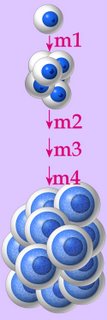Cancer
Alteration of a gene that normally controls cell growth can promote the uncontrolled growth characteristic of cancer. The normal forms of dominant genes that function in the various signal transduction cascades that regulate cell growth, proliferation and differentiation are termed proto-oncogenes, and the malignantly transformed genes are termed oncogenes.
For example, mutation in a proto-oncogene, such as a gene which encodes an intracellular signaling protein that is normally activated only by extracellular growth factors, converts the proto-oncogene into an oncogene. The malignantly transformed oncogene encodes an altered form of the signaling protein that now behaves as though activated even in the absence of growth factor binding. The malignant cell line has escaped normal gene regulation and cell cycle control mechanisms and exhibits unchecked proliferation.
A propensity for invasion and metastasis is a critical feature that distinguishes malignancies from benign tumors.
There are many excellent sites with information for those affected by cancer, so the purpose of this site, in conjunction with the companion sites, is an exploration of the cell and molecular biology of malignancy.
synonyms : cancer, tumor, malignancy, neoplasm; cancerous, tumorous, malignant, neoplastic; cancer, neoplasia, oncology.
¤¤ adenoviruses ¤ amplification ¤ carcinogenesis ¤ c-Fos ¤ c-Jun ¤ c-Myc ¤ c-Sis ¤ estrogen receptors ¤ gene amplification ¤ genetic predispositon ¤ HBV ¤ HIV ¤ HPV ¤ HTLV-I ¤ immune evasion ¤ irradiation ¤ malignant transformation ¤ metastasis ¤ mitogens ¤ mutagens ¤ MYC ¤ mutations ¤ neoplasia ¤ neoplastic mutations ¤ NF-κB ¤ non-mutagenic carcinogens ¤ oncogenes ¤ p53 ¤ proliferation ¤ proto-oncogenes ¤ radiation ¤ Ras ¤ Rb ¤ retroviral mechanisms of carcinogenesis ¤ retroviruses ¤ signaling molecules ¤ SRC genes ¤ T-antigens ¤ TP53 ¤ tumor antigens ¤ tumor suppressors ¤ tumorigenic viruses ¤ viral carcinogens ¤ v-Fos ¤ v-Sis ¤ v-Myc ¤
▲ Top ▲
tags [Cancer] [proto-oncogene] [mutation] [oncogene] [metastasis]
Labels: cancer, infiltration, invasion, metastasis, mutation, oncogene, proto-oncogene, tumor suppressor, uncontrolled proliferation
| 2 Guide-Glossary






































